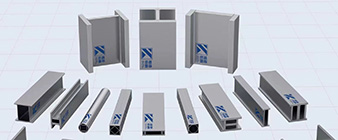Of course, the following is an introduction to the performance characteristics of 304 and 304L stainless steel:
Corrosion resistance:
304 stainless steel has excellent resistance to general corrosion, making it suitable for a wide range of applications.
It is resistant to atmospheric corrosion, mild acids, alkalis and many other corrosive media.
The chromium content (18-20%) in 304 stainless steel forms a passive, self-healing oxide layer that protects the base metal.
Mechanical Properties:
304 stainless steel has good mechanical strength, with a tensile strength range of 500-700 MPa and a yield strength range of 210-300 MPa.
It has a moderate hardness, typically in the range of 170-220 hb, making it suitable for applications requiring wear resistance.
The material is ductile and the elongation of cracks is approximately 45-55%. This can be easily formed and manufactured.
Solderability and Fabrication:
304 stainless steel is relatively easy to weld, and the welding area has good weld strength and corrosion resistance.
It can be easily formed, bent and machined, making it suitable for a wide range of manufacturing processes.
Corrosion resistance:
304L stainless steel has enhanced corrosion resistance, especially in welding areas, due to its lower carbon content (≤0.03%).
This makes it a preferred choice for applications in more corrosive environments such as the chemical, petrochemical and marine industries.
Solderability:
The lower carbon content of 304L improves its weldability and fitability.
This is beneficial for fabricated components and structures that require extensive welding, as it helps maintain the mechanical properties of the material in the heated area.
Mechanical Properties:
Compared with 304, the mechanical strength of 304L stainless steel is slightly lower, with a tensile strength range of 450-650 MPa and a yield strength range of 170-250 MPa.
Its hardness ranges up to 200 HB, just below 304.
-
 2024-9-21 S690QH/S690QLH Hollow structural Stations in Hong Kong
2024-9-21 S690QH/S690QLH Hollow structural Stations in Hong Kong -
 2024-9-25 1.4301 Stainless steel hollow structural profiles
2024-9-25 1.4301 Stainless steel hollow structural profiles -
 2024-9-19 UNS S32570 VS 1.4410 stainless steel structural profile
2024-9-19 UNS S32570 VS 1.4410 stainless steel structural profile -
 2024-9-20 1.4404 stainless steel structural profiles in civil engineering applications
2024-9-20 1.4404 stainless steel structural profiles in civil engineering applications -
 2024-9-29 Nickel Alloy C4 / 2.4610 Nickel alloy hollow structural profiles
2024-9-29 Nickel Alloy C4 / 2.4610 Nickel alloy hollow structural profiles -
 2024-9-29 Nickel Alloy C4 / 2.4610 Nickel alloy structural profiles
2024-9-29 Nickel Alloy C4 / 2.4610 Nickel alloy structural profiles -
 2024-9-29 Alloy 2.4663 (N06617) Structural Hollow Profiles
2024-9-29 Alloy 2.4663 (N06617) Structural Hollow Profiles



